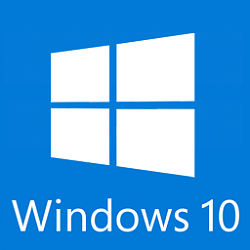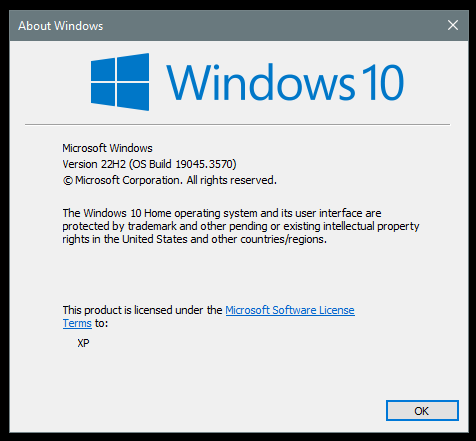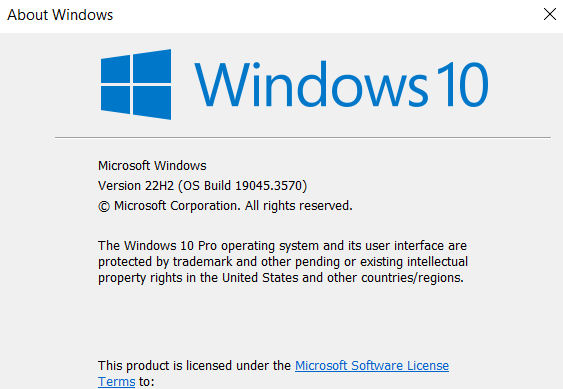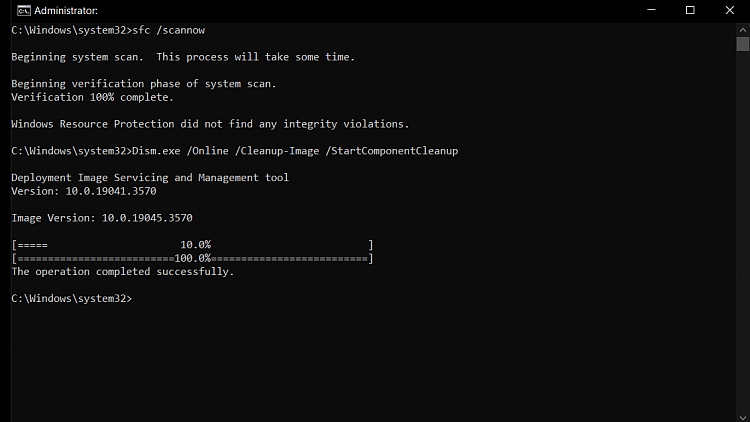New
#1
KB5031356 Windows 10 Cumulative Update Build 19045.3570 (22H2) Win Update
- This update addresses security issues for your Windows operating system.
- This build includes all the improvements from the supported Windows 10, version 21H2 editions.
- No additional issues are documented for this release.
- To protect against CVE-2023-44487, you should install the latest Windows update. Based on your use case, you can also set the limit of the RST_STREAMS per minute using the new registry keys in this update.
Registry key Default value Valid value range Registry key function Http2MaxClientResetsPerMinute 400 0–65535 Sets the allowed number of resets (RST_STREAMS) per minute for a connection. When you reach this limit, a GOAWAY message is sent to client for the connection. Http2MaxClientResetsGoaway 1 0-1 Disables or enables the GOAWAY message to send when you reach the limit. If you set this to 0, the connection ends as soon as you reach the limit. - Run Command Prompt as Administrator.
- In the Command Prompt window, type the following command:
Dism /online /cleanup-image /RestoreHealth - Wait for the process to complete successfully, and then close the windows.
- Install this update. To do this, select Start > Settings > Windows Update > Check for updates.
- Download for Windows 10, version 22H2 and Windows 10, version 21H2-Windows 10 20H2, 21H1, 21H2 and 22H2 KB5026879 230627_173533 Known Issue Rollback.msi
- For offline OS image servicing:
If your image does not have the March 22, 2022 (KB5011543) or later LCU, you must install the special standalone May 10, 2022 SSU (KB5014032) before installing this update. - For Windows Server Update Services (WSUS) deployment or when installing the standalone package from Microsoft Update Catalog:
If your devices do not have the May 11, 2021 (KB5003173) or later LCU, you must install the special standalone August 10, 2021 SSU (KB5005260) before installing this update. -
-
-
-
-
-
-
-
New #8
i am not sure but, after i clicked "restart," i saw a "restarting" message twice during the restarting process, making me think that it restarted twice.
-
-
New #9
If I had to pick any term to describe this update, it would be the phrase "preposterously slow"
Some of the slowness involved the Windows Defender update service running twice during the update, slowing down the process of the main update. Then it was slow on the restart from 0 to 30. Slow going from 30 to 100. There's a variety of "Winlogon notification subscriber took a long time to create session" warnings in the event viewer.
Did this update install the stuff necessary for a 23H2 update or what in the world went on?

KB5031356 Windows 10 Cumulative Update Build 19045.3570 (22H2)
Category: Win UpdateLast Updated: 26 Oct 2023 at 16:17
UPDATE 10/26: KB5031445 Windows 10 Cumulative Update Preview Build 19045.3636 (22H2)
October 10, 2023 - KB5031356 (OS Builds 19044.3570 and 19045.3570)
11/17/20
For information about Windows update terminology, see the article about the types of Windows updates and the monthly quality update types. For an overview of Windows 10, version 21H2, see its update history page.
Note Follow @WindowsUpdate to find out when new content is published to the Windows release health dashboard.
Highlights
Improvements
Note To view the list of addressed issues, click or tap the OS name to expand the collapsible section.
Windows 10, version 22H2
Important: Use EKB KB5015684 to update to Windows 10, version 22H2.
This security update includes quality improvements. Key changes include:
Windows 10, version 21H2 editions: Windows 10 Enterprise and Education, Windows 10 IoT Enterprise, and Windows 10 Enterprise multi-session
Important: Use EKB KB5003791 to update to Windows 10, version 21H2 on supported editions.
This security update includes quality improvements that were a part of update KB5030300 (released September 26, 2023). When you install this KB:
If you installed earlier updates, only the new updates contained in this package will be downloaded and installed on your device.
For more information about security vulnerabilities, please refer to the new Security Update Guide website and the October 2023 Security Updates.
Windows 10 servicing stack update - 19044.3562 and 19045.3562
This update makes quality improvements to the servicing stack, which is the component that installs Windows updates. Servicing stack updates (SSU) ensure that you have a robust and reliable servicing stack so that your devices can receive and install Microsoft updates.
Known issues in this update
Symptom Workaround Using the FixedDrivesEncryptionType or SystemDrivesEncryptionType policy settings in the BitLocker configuration service provider (CSP) node in mobile device management (MDM) apps might incorrectly show a 65000 error in the "Require Device Encryption" setting for some devices in your environment. Affected environments are those with the “Enforce drive encryption type on operating system drives” or "Enforce drive encryption on fixed drives" policies set to enabled and selecting either "full encryption" or "used space only". Microsoft Intune is affected by this issue but third-party MDMs might also pe affected.
Important This issue is a reporting issue only and does not affect drive encryption or the reporting of other issues on the device, including other BitLocker issues.To mitigate this issue in Microsoft Intune, you can set the “Enforce drive encryption type on operating system drives” or "Enforce drive encryption on fixed drives" policies to not configured.
We are working on a resolution and will provide an update in an upcoming release.This update might not be installed successfully. Devices might initially display progress, but then not finish the installation.
A common error code encountered with this issue is Error 8007000D (ERROR_INVALID_DATA). This error can be found in Update History.
To view your update history, select Start > Settings > Windows Update > Update history.This issue is resolved by using Known Issue Rollback (KIR). Please realize that it might require up to 48 hours for the resolution to propagate automatically to consumer devices and unmanaged business devices.
If necessary, use the following steps to resolve this issue:
For enterprise-managed devices that have installed an affected update and encountered this issue, it can be resolved by installing and configuring a special Group Policy. The special Group Policy can be found in Computer Configuration > Administrative Templates > <Group Policy name listed below>. For information on deploying and configuring these special Group Policy, please see How to use Group Policy to deploy a Known Issue Rollback.
Group Policy downloads with Group Policy name:
How to get this update
Before installing this update
Microsoft now combines the latest servicing stack update (SSU) for your operating system with the latest cumulative update (LCU). For general information about SSUs, see Servicing stack updates and Servicing Stack Updates (SSU): Frequently Asked Questions.
Prerequisite:
Based on your installation scenario, choose one of the following:
Install this update
Release Channel Available Next Step Windows Update and Microsoft Update Yes None. This update will be downloaded and installed automatically from Windows Update. Windows Update for Business Yes None. This update will be downloaded and installed automatically from Windows Update in accordance with configured policies. Microsoft Update Catalog Yes To get the standalone package for this update, go to the Microsoft Update Catalog website. Windows Server Update Services (WSUS) Yes This update will automatically sync with WSUS if you configure Products and Classifications as follows:
Product: Windows 10, version 1903 and later
Classification: Security Updates
If you want to remove the LCU
To remove the LCU after installing the combined SSU and LCU package, use the DISM/Remove-Package command line option with the LCU package name as the argument. You can find the package name by using this command: DISM /online /get-packages.
Running Windows Update Standalone Installer (wusa.exe) with the /uninstall switch on the combined package will not work because the combined package contains the SSU. You cannot remove the SSU from the system after installation.
File information
For a list of the files that are provided in this update, download the file information for cumulative update 5031356.
For a list of the files that are provided in the servicing stack update, download the file information for the SSU - versions 19044.3562 and 19045.3562.
Source: https://support.microsoft.com/en-us/...8-a9448920df1a
UUP Dump:
32-bit ISO download:
https://uupdump.net/selectlang.php?i...9-bfd855bf0df6
64-bit ISO download:
https://uupdump.net/selectlang.php?i...9-be98c74b5658
ARM64 ISO download:
https://uupdump.net/selectlang.php?i...d-f47a1503901d
https://www.elevenforum.com/t/uup-du...sider-iso.344/
Related Discussions



 Quote
Quote





